Elderflower tea is one of those gifts of nature that is a must-have for every food gatherer when stocking up for the winter. With its delicate yet fragrant flavor, it’s become a go-to choice for those seeking a refreshing and soothing drink. Besides that, it has many incredible health benefits.
Not only is the smell of the elderflower refreshing and very pleasant, but it’s also a relieving help for any kind of cold.
The flavonoids in elderflower tea have antibiotic and diuretic effects. It’s a proven home remedy for fever; it promotes sweating and strengthens our body to become more resistant to diseases.
Don’t miss out on the magic of this wonderful plant; pick a sunny day in the early summer, grab your basket and be ready to discover the secrets of elderflowers.
Besides traditionally made spruce tip syrup, ruby red St. John’s Wort infused oil and homemade helichrysum oil, elderflower tea is one of those gorgeously smelling DIY remedies that you don’t want to be without during the long winters.
- Elderberry (Sambucus Nigra) habitat
- The mystical world of elder tree mythology
- Elderflower tea benefits
- Elderflower tea – tips for harvesting
- How to dry elderflowers for tea
- How to store dry elderflower tea
- How to make elderflower tea
- Elderflower tea precautions
- Elderflower tea FAQs
- More from the food gatherer’s kitchen
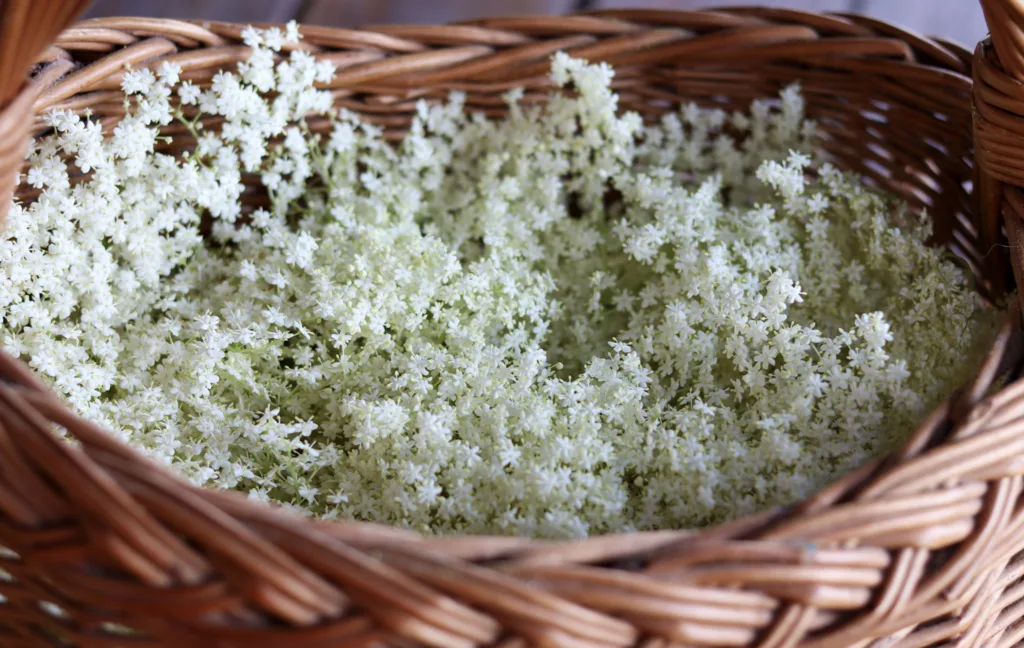
Elderberry (Sambucus Nigra) habitat
Elderberries are fascinating plants that can be found in various regions around the world. They are native to Europe, North Africa, and parts of Asia. However, due to their adaptability and popularity, they have been introduced to many other parts of the world. In terms of climate preference, elderberries thrive in temperate regions with mild summers and cold winters.
When it comes to choosing a spot for growth, elderberries aren’t too picky. You can find them growing in many different habitats, such as woodlands, hedgerows, meadows, stream banks, and even disturbed areas like roadsides or abandoned fields. Many times they will thrive around abandoned houses.
They love moist soil conditions but can tolerate occasional flooding as well. That’s why you often find them near bodies of water like rivers or lakes.
Elderberries like full sun exposure but can tolerate partial shade too. That allows them to grow under the canopy of taller trees or along forest edges where they receive less sunlight throughout the day. Typically they reach heights between 5-12 feet.
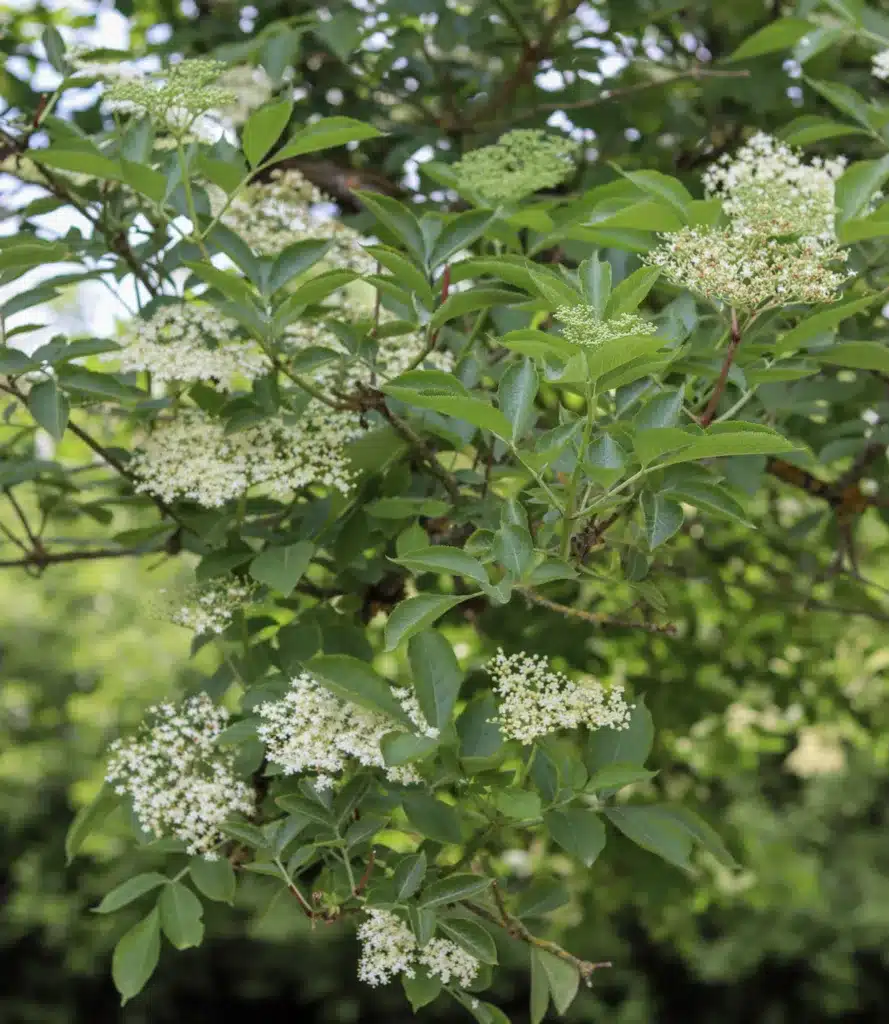
The mystical world of elder tree mythology
Since ancient times elder trees have had a prominent role in mythology and folklore around the world. In various cultures, the elder tree holds significance as a symbolic bridge connecting the realms of the living and the world on the other side.
The elder tree was also known as a plant of transformation, renewal and protection. It was believed that good spirits lived in the elder trees, taking care of the safety and well-being of the owner. People who had elder trees at home believed that these warded off all the bad things from the property, not only thieves but also witches and bad energy.
In Scandinavian lore, the Elder mother lived in the tree, and when someone wanted to touch the tree or cut, he first needed to ask for permission from the inhabitant. That included prayers and offerings; otherwise, the mother would cast a spell on the person. Still today, the gypsies believe that the elder tree shouldn’t be cut at all. Russian farmers spit three times before cutting down an elder tree to ward off evil spirits.

In English and Irish folklore, it was believed that the witches could turn themselves into an elder tree and elder tree wood was used to make magic wands and broomsticks. Elder trees were never burned, and food was never cooked over elder wood.
In some places, it was believed that one could see the faeries by sitting under an elder tree around the summer solstice. Though, that was described as somewhat dangerous because the person could eventually get stuck in the underworld by doing so.
In the Balkans, elder branches were used in the ritual summoning of rain. They decorated a doll with elder branches and threw it into the water. Russian travelers carried a piece of an elder branch with them, which was supposed to protect them from dangerous beasts and evil people. Some claim that it’s good to carry elder wood with you as it will protect you from adultery.
Besides many other protective capabilities, elder trees were also credited with the ability to protect against lightning. Old beliefs reveal that lightning will never strike a person under the elder tree. This probably originated from the legend that the cross on which Christ was crucified was made of elder wood.
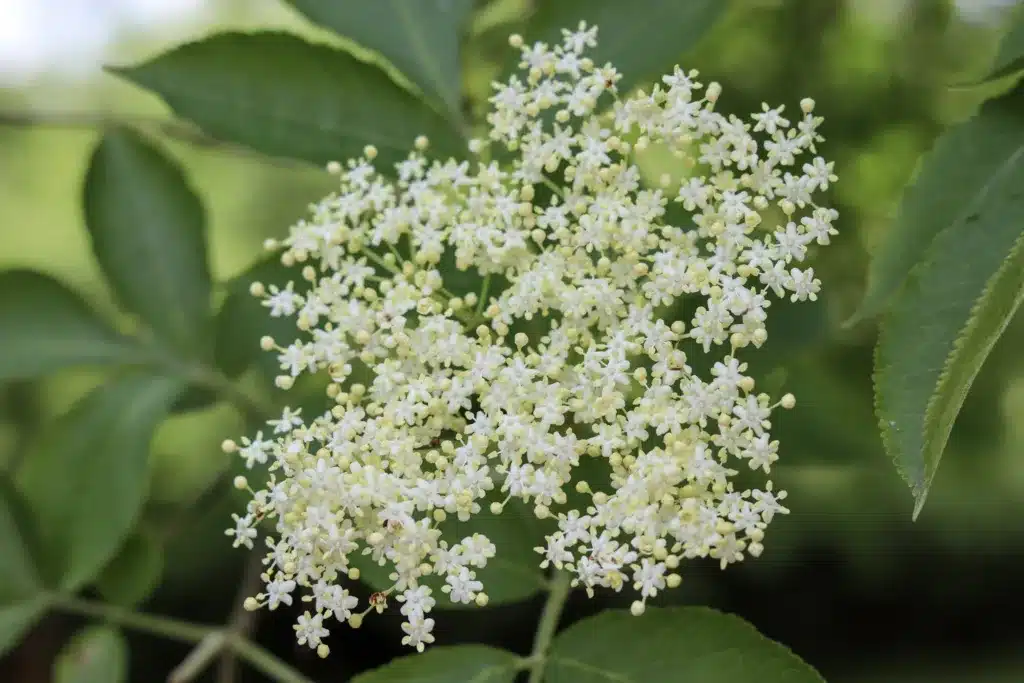
Elderflower tea benefits
BOOSTING THE IMMUNE SYSTEM
As elderflower tea is rich in antioxidants, including flavonoids and phenolic acids, it has the ability to strengthen your body’s defenses against unwanted free radicals. Therefore, elderflower tea is a powerful immune stimulator capable of potentially reducing the risk of various illnesses and maintaining a healthier immune system.
FIGHTING COLDS AND SOOTHING RESPIRATORY ISSUES
Drinking elderflower tea is especially recommendable during the cold season when the viruses spread. Active ingredients in the tea help to dissolve mucus during infections and relieve symptoms of colds, flu and respiratory diseases such as bronchitis or even pneumonia and asthma. They promote and increase sweating (diaphoretic) and faster recovery from fever. Elderberry has been used in folk medicine for centuries to treat influenza. The tea’s anti-inflammatory properties also help to alleviate congestion and provide relief for sore throats.
BLOOD CLEANSING
Within the elderflower’s tender embrace lies a powerful ally known as quercetin. This enchanting compound, found abundantly in elderflowers, possesses marvelous properties that have been associated with blood-cleansing effects. It promotes circulation and fortifies our blood vessels. Quercetin, with its remarkable antioxidant and anti-inflammatory nature, may safeguard our blood from the relentless assault of free radicals and oxidative stress.
REDUCING CHOLESTEROL
The quercetin in the elderflower may work by inhibiting certain enzymes involved in cholesterol synthesis. By impeding the activity of these enzymes, quercetin helps to regulate the production of cholesterol in our bodies. This regulation can potentially lead to a decrease in cholesterol levels, promoting a healthier balance within our cardiovascular system.

REDUCING BLOOD SUGAR
Flavonoids found in elderflower have been associated with potential anti-diabetic effects as well. These compounds may aid in improving insulin sensitivity, the hormone responsible for regulating blood sugar levels. By enhancing insulin function, elderflowers assist in maintaining balanced blood sugar levels. This regulation can potentially lead to a decrease in cholesterol levels, addressing type 2 diabetes and promoting a healthier balance within our cardiovascular system.
ANTIHISTAMINE POTENTIAL
Quercetin found in elderflowers, is also renowned for its antihistamine attributes. When our bodies encounter allergens, triggering an immune response, the release of histamine ensues, fostering a cascade of uncomfortable symptoms, such as itchiness, redness, and swelling. Quercetin, with its purported ability to counteract histamine release and quell inflammation, emerges as a potential knight in shining armor, offering respite for those plagued by itchy eyes and other allergic symptoms.
SOOTHING THE TOOTHACHES
The elderflower’s anti-inflammatory prowess bears the potential to assuage the throbbing pain and reduce the swelling often accompanying a toothache. In addition, anecdotal evidence suggests that elderflower exhibits mild analgesic qualities, providing ephemeral relief from discomfort. Keep the liquid in your mouth for a few minutes, and soon you should feel relief.
UPLIFTING THE MOOD AND FIGHTING DEPRESSION
As with many other healing properties of elderflowers, they may also aid in the fight against depression by acting as a natural mood enhancer. Their delicate aroma and graceful presence have the power to uplift our spirits, offering respite from the burdens that weigh us down. Moreover, elderflowers are believed to possess anti-inflammatory properties that can contribute to mental well-being. Inflammation has been linked to depression, and by reducing the inflammation in the body, elderflowers may indirectly support a more positive mental state.

Elderflower tea – tips for harvesting
Elder trees in the Northern Hemisphere usually bloom from May till the end of July.
The best time to harvest elderflowers is on a dry and sunny day when the sun is at its highest, around noon, and when the aroma and the pollen in the flowers are the richest.
It’s best to use a wooden harvesting basket when foraging for the elderflowers. Place a kitchen towel or a piece of old newspaper paper on the bottom of the basket to prevent the flowers from sipping through the openings.
Avoid collecting elderflowers after heavy rainfall, as the highly valuable pollen in the flowers will be washed away with the rain.
Choose flowers that are fully open and look healthy. Some are already browned; for those, we suggest you remove them.
You can pluck the stems with your hands or help yourself with a small knife or scissors. Avoid flowers with a lot of insects, especially the ones that seem to be infested with aphids. Aphids adore elderflower stems, but most often, you won’t even notice them before you’ve already cut or plucked the flower stems.
You will do a generous favor to nature if you avoid harvesting all the flowers from the same elder tree. It’s much better to pick just a few flowers from each one; doing so will greatly help the bees and the plant itself, on which the fruits (that are also edible) will grow later.

How to dry elderflowers for tea
STEP 1: Before drying the flowers, once again, check for insects. Do not shake the umbels; you don’t want the precious pollen to fall out of the flowers. If you find any, remove them gently by hand.
STEP 2: Lay the umbels on a clean kitchen towel or used newspaper; make sure that the flowers are evenly placed so that the air can circulate between them. Another alternative is to hang the umbels on a string.
Let me remind you that when the flowers are dry, you will need to remove the stems as they contain cyanide-inducing glycosides, which cause a toxic buildup of cyanide in your body. The smaller stems around the flowers are basically harmless, but the larger ones are better to be removed.
Depending on what you prefer, you can cut the flowers off the umbels using the scissors before drying them, or remove the stems later, when the elderflowers are already dry.
STEP 3: The ideal temperature for drying herbs is between 86 and 100 F (30 – 40 degrees Celsius). Drying at higher temperatures is not suitable as the essential oils from the herbs evaporate easier. Elderflowers for tea should be dried in an airy place in the shade.
STEP 4: Turn the flowers around every two days. The whole drying process should be finished in two weeks.
How do you know when the flowers are dry enough? Hold them in your hand and try to crush them. When the flowers rustle between your fingers and start crushing, the drying process is usually completed.
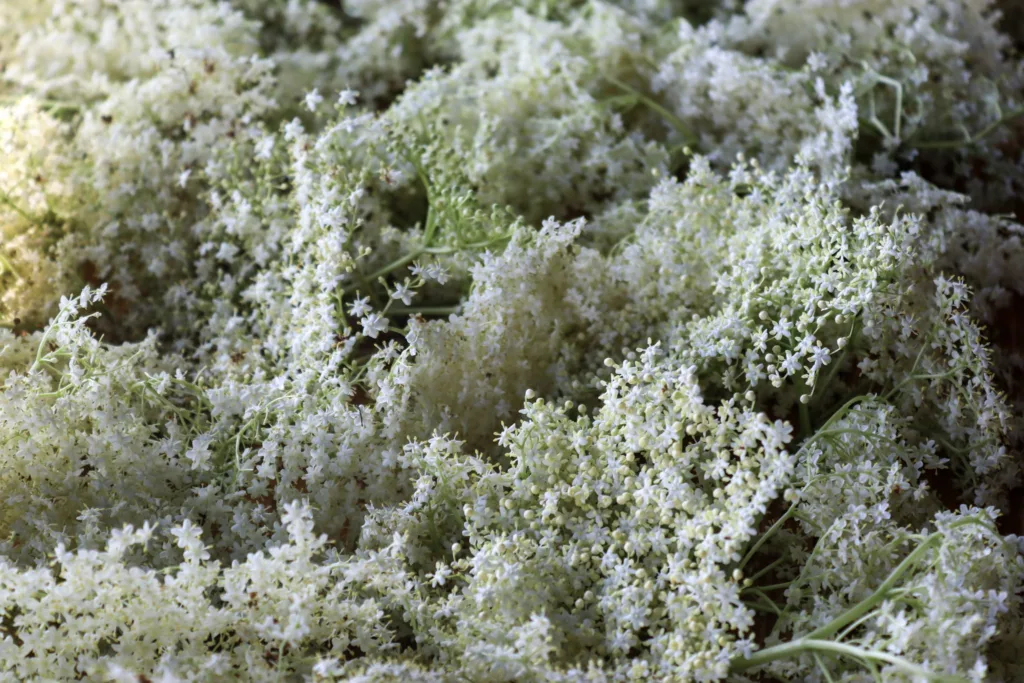
How to store dry elderflower tea
STEP 5: Once the elderflowers are dry enough, store them in jars, covered with a lid or paper bags in a dry and dark place.
STEP 6: What you want to do lastly is to label the jars (or bags) with the name of the tea. Do not forget to write the date of storage as well; this comes in handy when you need to judge whether the tea is still usable or not.
Dried elderflowers, when stored correctly, will last up to a year. Within a year, they will somewhat lose their aromatic substances, so you want to replace them next early summer with a fresh new batch of elderflower tea,

How to make elderflower tea
When your elderflower tea is dried and stored, preparing the tea is really easy.
Simply put two teaspoons of elderflower tea in a teacup (about 0,25 l) and pour over boiled water. Cover the cup and steep for about 10 minutes.
When your tea is loose, it’s somewhat easier to prepare it with a tea infuser. Once the tea is ready, just remove the infuser, and voila, your hot elderflower tea is ready.
Sweeten it with honey, add some fresh lemon juice, and indulge in the gentle, magical taste of elderflower tea.
By adding a few lemon juice drops and a few ice cubes, elderberry tea can also be transformed into a refreshing summer drink.
A small hint – elderflower tea goes gorgeously well with sweet empanada cookies, pear cheese strudel or puff pastry cinnamon pinwheels.

Elderflower tea precautions
- As already mentioned, elderberry petals (as well as stems and leaves) might contain toxic ingredients; therefore, they should be removed before or after drying the flowers for the tea. However, small petals around the flowers are not harmful.
- Elderflower tea should be dried properly to avoid harmful molds building up on the flowers.
- Pregnant women should not drink more than 3 cups of elderflower tea daily; it’s best if the tea is combined with some other tea.
- In combination with certain other plants (or medicines that you are taking), elderflower tea can cause stomach upset or allergic reactions.
- If you are taking diabetes medication, excessive amounts of elderflower tea could lower your blood sugar levels too much. It’s advisable to monitor your blood sugar levels.
- Because of the same reason, avoid drinking elderflower tea two weeks before surgery.
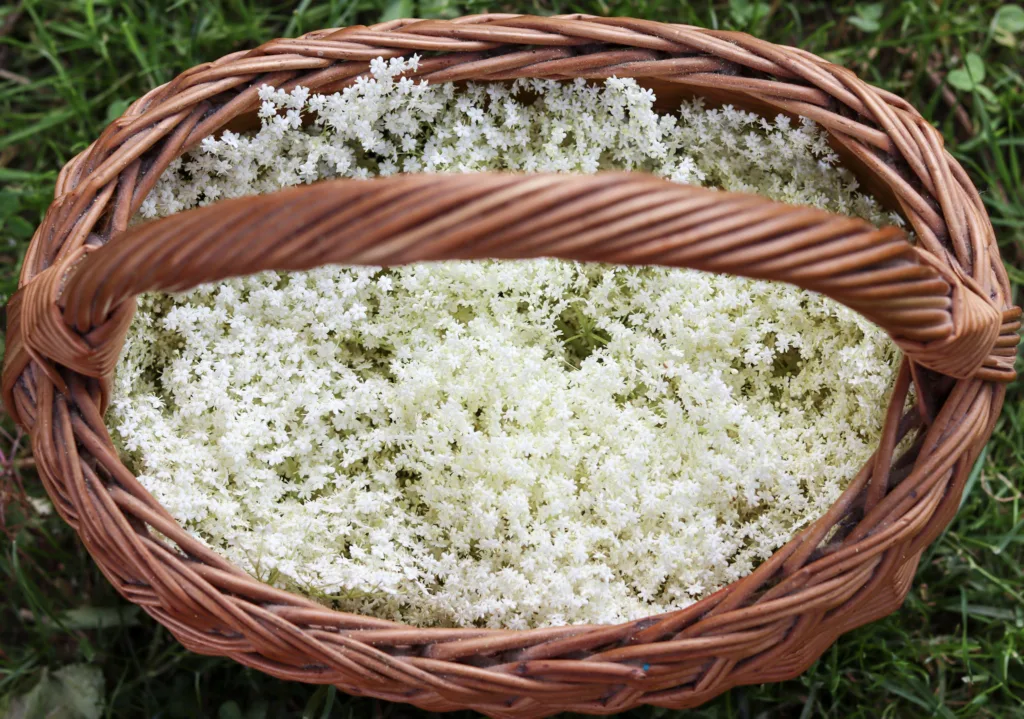
Elderflower tea FAQs
You should not drink more than one to two cups of elderflower tea three times daily.
Elderflower tea is considered to be safe when used for short-term medicine or consumed in refreshing drinks; however, prolonged use and high dosage could be harmful; therefore, practice it with caution.
Elderflower tea pairs well with a variety of other teas, including chamomile, mint, lemon and citrus teas, lime blossom, rose tea, marigold, ribwort and thyme. One of the sweetest combinations is a mix of elderflowers, lime blossom, rose tea and honey.
Elderflowers will always turn brown when dried, but it’s crucial to keep them away from direct sunlight when drying. Sunlight can fade their natural color and make them appear darker. Also, you should find a cool, dry spot with good airflow to dry your elderflowers. Avoid excessive heat, as it also tends to make them darker. Once your elderflowers are completely dried, store them in a cool, dark place in an airtight container. This helps maintain their color for a longer time.
No, elderflower tea is caffeine-free.
Elderflower tea is generally not known to make you feel sleepy. It’s actually quite refreshing and soothing. However, everyone’s response to herbal teas can be different. Some people might feel a sense of relaxation or calmness after sipping on elderflower tea, which could potentially contribute to a more relaxed state that might aid in falling asleep.
You can find elderflower tea bags at various places, both online and offline. We strongly suggest you go for naturally dried elderflower tea.
No, elderflower and Queen Anne’s lace are not the same. They’re two different plants with their own unique characteristics. Elderflower refers to the flowers of the elderberry plant (Sambucus nigra); Queen Anne’s lace (Daucus carota), on the other hand, is a wildflower from the carrot family. You can spot a tiny dark purple or red dot in the center of Queen Anne’s lace flowers, which is what easily sets them apart from elderflowers.
More from the food gatherer’s kitchen
How to make St. John’s Wort infused oil
How to make helichrysum oil at home
Green gnocchi with wild spinach
Elderflower Tea
EQUIPMENT
- herb gathering basket
- kitchen towel or parchent paper
- long strain (optinal)
- airtight jars with lids or paper bags
INGREDIENTS
- 2 tsp naturally dried elderflowers
- 1 cup boiled water
- 1 tsp honey (optional)
- 1 tsp fresh lemon juice (optinal)
INSTRUCTIONS
- Choose a dry, hot, sunny day when the elder trees are in full bloom.
- Forage healthy looking, fully opened elderflowers from the elder tree. Handle them gently and check for insects and aphids. Remove the insects and browned flowers from the umbels, avoid shaking the umbels. Gently place elderflowers to the basket.
- Remove the petals from the elderflowers before drying them or after they've been dried.
- At home once again check for insects. Place the flowers on a clean kitchen towel, parchment paper or hang them on a long strain. There must be enough air circulating between the flowers.
- Avoid direct sunshine and dry the elderflowers for the tea in a shaddy and airy place for about two weeks. Turn the flowers around every two days to avoid mold from building up.
- Store in airtight jars with lids or paper bags in a dark and dry place.
- Label the jars or bags with the name of the tea and date of storage.
- Use elderflower tea in one year time, before you can stock up on another batch of elderflowers.
- To prepare a cup of elderflower tea use two tsp of dried elderflowers. Pour over a cup of boiled water. Cover the cup and steep for about 10-15 minutes. Add fresh lemon juice and honey (optional).
- For cold elderflower tea drink in the summer, add honey and lemon juice and let the elderflower tea cool down to room temperature. Before serving add a few ice blocks.
Video
NOTES
- Avoid foraging for elderflowers near roads, heavy traffic, intensive farming areas and industrial areas.
- It’s best to harvest when the sun is the brightest, around noon; that’s when the aroma and the pollen in the flowers are the richest.
- Place a kitchen towel or a piece of paper on the bottom of the basket to prevent pollen from shaking out of the basket.
- Avoid collecting elderflowers after heavy rainfalls.
- Aphids adore elderflowers, but you usually won’t see them before you pluck the umbels. Remove them before drying the elderflowers.
- Do not gather all the elderflowers from the same tree; the bees will be happy if you don’t, and you’ll be able to come back to the tree later to harvest elderberries.
- The ideal temperature for drying herbs is between 86 and 100 F (30 – 40 degrees Celsius). Drying at higher temperatures is not suitable as the essential oils from the herbs evaporate easier. Avoid drying elderflowers in direct sun.
- Dry elderflowers will retain their color and aroma easier when stored in airtight glass jars.
- Excessive amounts of elderflower tea or its prolonged usage could prove harmful.
- If you are taking other medicines for blood sugar levels, please consult with your doctor about daily consuming elderflower tea. Limit drinking elderflower tea during pregnancy.
- Avoid drinking elderflower tea two weeks prior to surgery.
- One of the sweetest-tasting tea blends that include elderflowers is a combination of elderflowers, lime blossom, rose tea and honey.
NUTRITION
Featured at
If you liked this elderflower tea recipe, please rate it in the comments below.
Show your love by sharing ❤️

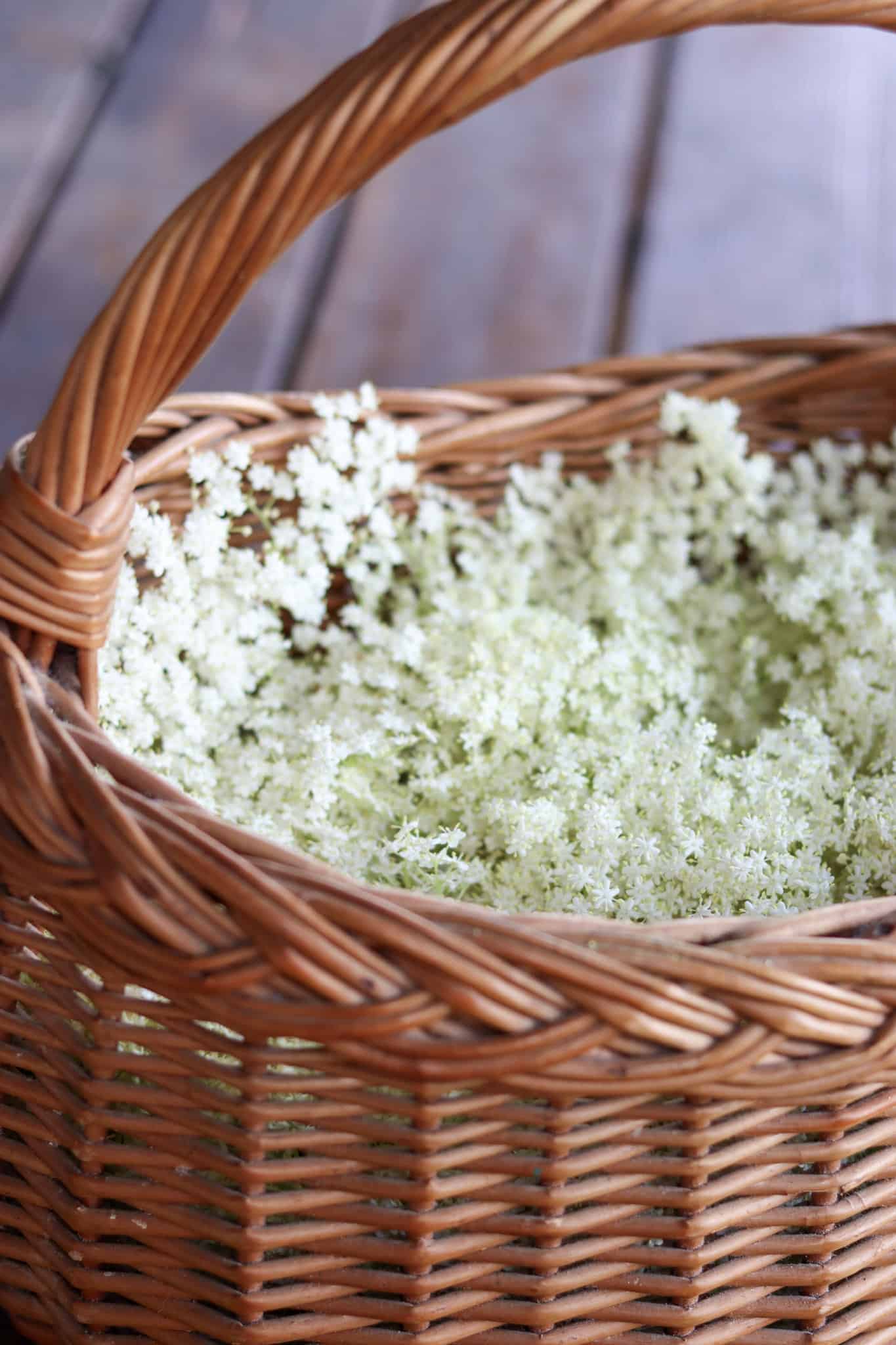


I never could have enough of elderflower tea, it’s definitely one of the best remedies for fighting colds. Lovely photos!
Thanks!
Such magic in Mother Nature! Thank you for sharing the benefits of elderflower tea – I am feeling inspired to add this to my diet.
Thank you Stephanie, elderflower tea is really a must have and it’s always free, you just need to find it 🙂
What a brilliant article, just fascinating. I will certainly look out for this on my walks. #MMBC
Thank you Joe, stocking up with elderflowers for the winter is something that I do every year without exception.
I had no idea elderflowers had so many health and healing benefits. Thank you for sharing!
#mmbc
Indeed, elderflowers are somewhat magical.
This was super educational!! I had no idea elderflowers held so many benefits. Thank you so much for sharing at Home Imagined this week!!
My pleasure Rachel 😉
I am not a big tea drinker, but this does sound interesting.
Thank you from your SSPS Team for sharing your links with us at #269 SSPS Linky.
Indeed, elder tree is an amazing tree with many amazing benefits.
What a gorgeous post! I wish I had elderflowers in my garden. They flowers are so beautiful too…I love elderflower syrup too. How lovely it is to make your own tea 😀
Thanks Tammy, there definitely is some magic in these trees… It’s realy beautiful to see them flower so I hope you will find some baby tree somewhere and bring it to your garden.
Mariama, this was such an interesting read.
Thank you for sharing how to harvest, dry and make elderflower tea at Create, Bake, Grow & Gather this week. I’m delighted to be featuring this post at tonight’s party and pinning too.
Hugs ~ Kerryanne
Awwww, thank you Kerryanne, it’ so pleasant to hear you liked it. Wish you thousands more happy elderflower days 🙂 Hugs returned 🙂
I only drink black tea, but my husband is a fan of herbal teas. Thanks for sharing with #pocolo
Always my pleasure 🙂
Thank you for sharing all the wonderful benefits. I have been using teas to help with my daily water intake during pregnancy. Going to have to try!
Absolutely, hope you’ll enjoy it 🙂
Love it when beautiful plants are useful too – this tea sounds delicious! Thanks for sharing with #TheGardenYear
Same here, that’s why I had to do make a post about these white beauties.
I am a big fan of black tea but I do enjoy elderflower tea too. I must admit, I had no idea the amount of health benefits that it brings!
Thanks so much for sharing with #MMBC. Hope you join us again! 🙂
Thanks Jayne, I hope I did encourage you to go out and harvest some of these divine smelling flowers 🙂